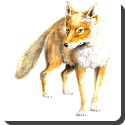 Coyote — The coyote (Canis latrans), also known as the prairie wolf, is a mammal of the order Carnivora. The species is found throughout North and Central America, ranging from Panama in the south, north through Mexico, the United States, and Canada. It occurs as far north as Alaska and all but the northernmost portions of Canada. There are currently 19 recognized subspecies, with 16 in Canada, Mexico and the United States, and 3 in Central America.
Coyote — The coyote (Canis latrans), also known as the prairie wolf, is a mammal of the order Carnivora. The species is found throughout North and Central America, ranging from Panama in the south, north through Mexico, the United States, and Canada. It occurs as far north as Alaska and all but the northernmost portions of Canada. There are currently 19 recognized subspecies, with 16 in Canada, Mexico and the United States, and 3 in Central America.
The name “coyote” is borrowed from Mexican Spanish, ultimately derived from the Nahuatl word coyotl. Its Latin name, Canis latrans, means “barking dog.”
The color of the coyote’s pelt varies from grayish brown to yellowish gray on the upper parts, while the throat and belly tend to have a buff or white color. The forelegs, sides of the head, muzzle and feet are reddish brown. The back has tawn-colored underfur and long, black-tipped guard hairs that form a black dorsal stripe and a dark cross on the shoulder area. The black-tipped tail has a scent gland located on its dorsal base. Coyotes shed once a year, beginning in May with light hair loss, ending in July after heavy shedding. The ears are proportionately large in relation to the head, while the feet are relatively small in relation to the rest of the body. Mountain dwelling coyotes tend to be dark furred while desert coyotes tend to be more yellowish in color.
Coyotes tend not to roam in large packs as wolves do, though they have been observed to travel in small, single-sexed groups. These groups are usually not as unified as wolf packs, and members will readily disperse and regroup. The collective name for a group of coyotes is a band, a pack, or a rout. Coyotes are primarily nocturnal but can occasionally be seen during daylight hours. Coyotes were once essentially diurnal, but have adapted to more nocturnal behavior with pressure from humans (McClennen et al, 2001).
 Kids Portal For Parents India Kids Network
Kids Portal For Parents India Kids Network






